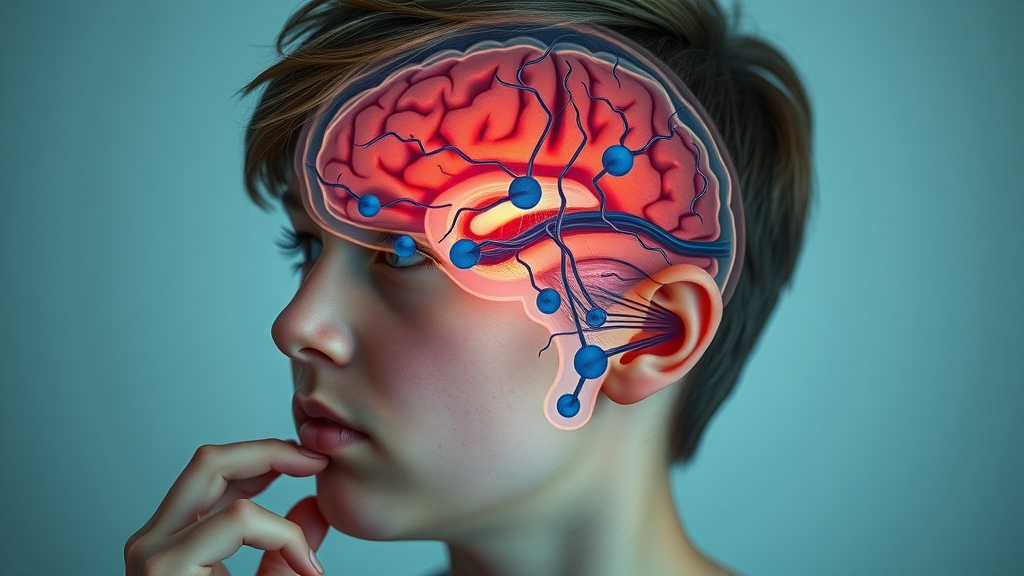Did you know that nearly 80% of teens admit to having engaged in at least one risky behavior before age 18? Understanding why is crucial for every parent. The teenage years are a whirlwind of emotions, peer pressures, and new freedoms—which can result in both positive risk taking and harmful risky behaviors. As a parent, recognizing the real forces behind teen risk taking behavior isn’t just important, it’s essential to keeping your teen safe and supporting their growth. In this guide, you’ll get a data-driven look at what drives teens to engage in risky behaviour, how mental health factors in, and—most importantly—what you can do to guide your child during these formative years.
Unveiling Teen Risk Taking Behavior: The Startling Reality
"Did you know that nearly 80% of teens admit to having engaged in at least one risky behavior before age 18? Understanding why is crucial for every parent."
Teenagers are biologically and socially wired to explore, push boundaries, and sometimes engage in risky behaviour. Recent studies show that risk taking is a nearly universal part of adolescent development, often happening before the age of 18. These behaviors span from experimenting with substances to taking risks online. While this can be a natural, even necessary, aspect of growing up, it can also result in negative consequences—from physical harm to mental health issues. Parents and caregivers in the United States and beyond often ask, "Why do young people take these risks, and how can we help them stay safe?" This article provides answers grounded in research and real-world advice.

What You'll Learn About Teen Risk Taking Behavior
The psychology behind teen risk taking behavior
Key risky behaviors and their triggers
How mental health influences risky behavior
Practical strategies parents can use to address and reduce risk
Real-life expert insights and actionable tips
Understanding Risky Behaviour and Risk Taking in Teenagers
Defining Teen Risk Taking Behavior and Risky Behaviour
Teen risk taking behavior refers to actions that expose young people to harm or the potential for negative consequences. These can include experimenting with drugs or alcohol, unsafe sexual activity, reckless driving, and other forms of dangerous conduct. Risky behaviours are sometimes perceived as "rites of passage," but the urge to take risks during the teenage years stems from complex psychological and neurological changes. It's important to remember that not all risk taking is negative—some "positive risks," such as trying out for a sports team or public speaking, can promote growth and resilience. However, the focus here is on behaviors that genuinely threaten safety and wellbeing.
What sets adolescent risk behavior apart from adult patterns is the developmental stage of the teenage brain. Adolescents often struggle with impulse control and have heightened sensitivity to rewards, making them more prone to seek new experiences—even those with unsafe outcomes. Understanding the distinction between curiosity-driven exploration and genuinely harmful risk behaviors is the first step in supporting healthy decision making.
The Prevalence of Risky Behaviors Among Teens
Surveys show that risky behaviour is both frequent and varied among teens. According to the Centers for Disease Control (CDC) and the National Institute on Drug Abuse, more than half of high schoolers have tried alcohol, and nearly a third have tried tobacco by age 18. The prevalence of risk behaviors like substance abuse, dangerous driving, and online bullying varies across regions and demographics, but the common thread is clear—most teens will encounter, or even engage in, multiple forms of risky behavior before reaching adulthood.
Parents should be aware that these behaviors tend to cluster; a teen who engages in one form of risk taking is often more likely to take further unsafe actions. This is why early intervention and open conversation are so critical. By understanding the types of risky behavior most commonly seen, parents can be more alert to warning signs and respond with support rather than punishment.
Comparing Types of Teen Risky Behaviour |
||
Type of Risky Behavior |
Prevalence (%) |
Associated Risks |
|---|---|---|
Substance abuse |
60% |
Drug abuse, addiction, legal trouble |
Reckless driving |
35% |
Injury, fatality, financial loss |
Unsafe sexual behavior |
32% |
STDs, unintended pregnancy |
Bullying/Violence |
20% |
Physical harm, emotional trauma |
Internet/social media risks |
45% |
Cyberbullying, privacy loss, exploitation |
Exploring the Teenage Brain: Why Risk Taking Increases
Neurological Factors: Teenage Brain Development and Risky behaviour
During adolescence, profound changes occur within the teenage brain. The prefrontal cortex—responsible for judgment, impulse control, and decision making—is still developing, while the limbic system (the emotional center of the brain) is more active and highly responsive to rewards. This imbalance explains why teens are more likely to take risks, even when aware of potential dangers. Neurologically, teenagers process emotions and threats differently from adults, resulting in a higher likelihood of pursuing novel—and sometimes unsafe—experiences.
The ongoing maturation of neural pathways makes teens more susceptible to peer influence and less likely to fully comprehend long-term consequences. Studies indicate that exposure to stress, social media, and even certain family dynamics can exaggerate these neurological tendencies. Consequently, repeated engagement in risky behaviours may set a precedent for future risk behavior and influence mental health outcomes well into adulthood.

Decision Making Processes in Teenagers
Adolescent decision making is unique due to the interplay of impulsivity, emotional reactivity, and intense desire for social acceptance. Unlike adults, teens often weigh immediate rewards more heavily than potential negative consequences. For example, the urge to impress friends or fit in can outweigh the logical awareness of potential harm—a dynamic known as “hot cognition.” In situations charged with excitement or peer pressure, a teen’s developing brain may bypass risk assessment altogether.
This pattern helps explain why “just talking about consequences” with young people isn’t always effective. It's not just about knowing right from wrong, but about how the teenage brain processes risks and rewards in real-time. Understanding this helps parents reframe their approach—focusing on coaching, curiosity, and shared decision making rather than rules and reprimands alone. Effective communication and emotional support can enhance teens' capacity to make safer choices, even in stressful or high-pressure scenarios.
Key Factors That Drive Teen Risk Taking Behavior
Psychological Causes of Risk Taking
Several psychological factors contribute to teen risk taking behavior. These include the quest for identity, need for independence, and the ongoing development of self-esteem. As teens seek new experiences and strive to define themselves outside family boundaries, they may be drawn toward behaviors that provide excitement or social approval. Emotional volatility, a hallmark of adolescence, can further amplify the likelihood of taking risks.
Impulsiveness, sensation-seeking, and a propensity to underestimate risk are all common during the teenage years. Even among those with strong supportive networks, the urge to "try something new" and "test limits" is powerful. Recognizing that taking risks isn't a flaw, but a developmental phase, can help parents offer empathy alongside guidance, ensuring that their teens are supported as they make—and recover from—mistakes.
Influence of Mental Health on Risk Behaviors
Teen mental health has a profound impact on the kinds of risks adolescents are willing or likely to undertake. Issues such as depression, anxiety, ADHD, and trauma can increase the tendency to seek out risky behaviour as a form of escape, self-medication, or expression. At the same time, emotional distress can inhibit healthy decision making, making it tougher for teens to assess dangers accurately.
Early signs of trouble—withdrawal, sudden changes in friends or routines, declining grades—may indicate underlying mental health struggles. Being proactive about mental health, rather than reactive, enables parents and caregivers to intervene before risk behavior spirals into serious harm. When mental health concerns are addressed sensitively and early, teens are more likely to adopt healthy coping techniques and safer social behaviors.

Role of Peer Pressure and Social Influence
Peer influence is perhaps the strongest external factor driving teen risk taking behavior. As young people begin prioritizing relationships outside the family, acceptance from friends can become more important than parental approval. Peer groups often reinforce shared behaviors, whether positive or negative, and can directly encourage risky actions like underage drinking, substance abuse, or even dangerous social media challenges.
This influence is compounded by the prevalence of online communities and instant communication, where risky behaviours can spread quickly and be perceived as "normal" or "cool." Parents need to be aware that simply telling teens to "choose better friends" doesn't counteract this deep-seated desire for belonging. Instead, helping teens build self-confidence and critical thinking skills will better equip them to resist harmful peer group pressures.
Media, Technology, and Risky Behaviors
With the omnipresence of smartphones, social media, and streaming content, today's teens are bombarded with images and narratives that normalize—or even glamorize—risky behaviour. From viral challenges to curated portrayals of substance use, media can distort perceptions about what is typical or safe. The lines between online and offline risk taking are increasingly blurred. A single impulsive action, documented online, can lead to lifelong negative consequences.
Parents and caregivers must actively engage with their teens regarding their digital lives, understanding not just screen time but the content and interactions shaping their worldview. Encouraging digital literacy, open discussion of online risks, and modeling balanced technology use all form part of a robust defense against media-driven risk behaviors. Ultimately, teaching teens to critically evaluate online content is essential in today's hyper-connected landscape.
Common Risk Behaviors in Teens: An Overview
Substance abuse
Reckless driving
Unsafe sexual behavior
Bullying and violence
Delinquency
Internet and social media risks
Short-Term and Long-Term Impacts of Teen Risk Behaviors |
||
Risk Behavior |
Short-Term Impact |
Long-Term Impact |
|---|---|---|
Substance abuse |
Impaired judgment, accidents, school trouble |
Addiction, health decline, legal issues |
Reckless driving |
Traffic violations, injuries |
Lasting disabilities, criminal record |
Unsafe sexual behavior |
STDs, unplanned pregnancy |
Infertility, long-term health costs |
Bullying/Violence |
Impact on victims, school penalties |
Emotional trauma, social stigma |
Internet/social media misuse |
Cyberbullying, privacy loss |
Reputational damage, exploitation risk |

The Link Between Mental Health and Teen Risk Taking Behavior
How Mental Health Issues Contribute to Risky Behavior
There’s a strong correlation between mental health and risky behaviors during adolescence. Disorders such as depression, anxiety, ADHD, and unresolved trauma can intensify feelings of isolation or emotional pain, pushing teens toward dangerous behaviors as a means of coping or self-expression. For many young people, substance abuse, unsafe sex, or extreme thrill-seeking provide temporary relief from psychological distress, but often at the cost of lasting harm.
Addressing the underlying emotional issues is crucial. Teens are more likely to engage in risky behaviour if they lack effective coping skills or support systems. Thus, mental health screening, supportive counseling, and family engagement are powerful tools for reducing risk-taking and promoting resilience. Creating a stigma-free environment around mental health care can help teens ask for help before risky behavior becomes their primary outlet.
Identifying Signs of Underlying Mental Health Challenges
Parents play a pivotal role in recognizing the early signs of mental health struggles. Warning signs may include withdrawal from friends or family, sudden changes in behavior, persistent sadness, irritability, poor academic performance, unexplained aches, or extreme changes in eating and sleeping patterns. Often, these symptoms appear before the onset of serious risky behaviour.
Open communication and consistent observation are key. Rather than viewing concerning behaviors as “just a phase,” approach them as signals that your teen may need additional support. If in doubt, reaching out to a mental health professional ensures your child gets the attention they need to reclaim control over both their emotions and actions.

"Addressing mental health is often the first step to reducing harmful risk behaviors in teens." – Dr. Lisa Mark, Adolescent Psychologist
Strategies for Parents: Reducing Teen Risk Taking Behavior
Communication Techniques for Discussing Risky Behaviour

Effective communication is the cornerstone of prevention and intervention. Start conversations early—before risky behavior arises—and maintain a nonjudgmental, open-minded stance. Ask open-ended questions, validate your teen’s feelings, and avoid lecturing or overreacting. When teens feel trusted and understood, they are more likely to share their struggles and experiences, making it easier to spot and address risks early.
Active listening, empathy, and checking in regularly create an atmosphere where teens can be honest without fear of punishment. Use real scenarios to spark discussion (“What would you do if...?”) and share your own experiences when relevant. Remember, it’s not about having the perfect answer, but about building trust and keeping lines of communication open.
Setting Boundaries and Encouraging Good Decision Making
While teens crave independence, they also need clear boundaries to feel secure. Establish concrete rules regarding curfews, driving, substance use, and internet activity. Explain your reasoning and the consequences (positive and negative) of their decisions. Rather than a rigid “no questions asked” approach, strive for collaborative rule-making—allowing your teen to contribute, ask questions, and negotiate.
Teach your child how to assess risks by practicing “what if” scenarios and discussing real-life examples. Celebrate responsible behaviour with positive feedback, and use mistakes as learning opportunities—not grounds for shame. Empowering teens with decision making skills prepares them to resist negative peer influences and handle pressure with confidence both now and into adulthood.
When to Seek Professional Help for Mental Health and Risk Behaviors
Some situations require more than parental support. If risky behaviour persists, intensifies, or is accompanied by signs of depression, anxiety, or withdrawal, consider seeking help from a qualified mental health professional. Early intervention is far more effective than waiting for a crisis to develop. Health professionals can provide therapy, develop safety plans, and connect teens to resources designed for their unique needs.
Never hesitate to reach out if your teen talks about self-harm, substance abuse, or suicide. Many communities offer adolescent-focused mental health services and hotlines—use them when needed. Remember, supporting your teen’s mental health is an act of strength, not failure as a parent.
Real-Life Success Stories: Teens Overcoming Risky Behavior
A 15-year-old who turned away from substance abuse after family counseling and school support.
A teen girl who overcame cyberbullying and risky social media habits through a mentorship program.
A student who improved decision making and impulse control after joining a school leadership club.
Young people who credited open, honest communication with parents for their ability to avoid risky behaviours.
People Also Ask: Answers to Top Questions on Teen Risk Taking Behavior
What are the risk taking behaviors of teenagers?
Answer: Teen risk taking behaviors include experimentation with substances, risky driving, unsafe sex, and defiance of rules. These often stem from neurological, environmental, and psychological factors.
What are 5 common high risk behaviors?
Answer: Five common high risk behaviors in teens are: Substance abuseReckless drivingUnprotected sexViolence or bullyingInternet and social media misuse.
What are the six risk behaviors for teens?
Answer: The CDC identifies six categories: behaviors leading to unintentional injuries/violence, alcohol/tobacco/drug use, sexual behaviors contributing to STDs and pregnancy, unhealthy dietary behavior, inadequate physical activity, and bullying.
What is risk-taking behavior a symptom of?
Answer: Risk-taking behavior can be a symptom of underlying issues, including mental health challenges such as ADHD, depression, anxiety, trauma, or impulse-control disorders.
FAQs on Teen Risk Taking Behavior
How can I talk to my teen about risky behavior?
Begin with open, non-judgmental conversation, using real-life situations and asking for your teen's perspective. Listen actively, validate their feelings, and maintain regular check-ins to encourage honesty and trust.At what age is risk taking most common in teenagers?
Risk taking behavior is most prevalent between ages 13-18, with a peak around ages 15-17, as neurological and social development accelerates.What resources are available for parents?
There are numerous resources, including school counselors, community programs, national helplines, and online support groups tailored for parents addressing adolescent risk behaviors.How do schools address risky behaviors?
Schools use comprehensive health education, peer support groups, mental health services, and communication campaigns to educate teens and reduce risk behaviors. Collaboration with parents further strengthens these efforts.
Key Takeaways: Helping Teens Navigate Risk Taking Behavior
Risk taking is a natural but potentially dangerous phase of adolescence
The teenage brain and peer influences are major drivers
Mental health is closely intertwined with risk behaviors
Open communication and early intervention are key for parents
Conclusion: Empowering Parents to Address Teen Risk Taking Behavior
Recap of actionable steps parents can take to recognize, address, and guide healthy choices
Empowerment starts with understanding, continues with open dialogue, and succeeds with early action. Recognize risk, support mental health, communicate honestly, and be proactive—these steps help teens make safer, healthier decisions during their most formative years.
Understanding why teenagers engage in risk-taking behaviors is crucial for parents aiming to guide their children safely through adolescence. The article “Understanding Teens and Risk-Taking Behaviors” from Kidstuff Counseling delves into the neurological and social factors that drive such behaviors, offering insights into brain development and peer influences. (kidstuffcounseling.com) Similarly, the University of Minnesota Extension’s piece, “Teens and Risk-Taking,” discusses how adolescents make decisions differently than adults and provides strategies for parents to support their teens in making safer choices. (extension.umn.edu) If you’re serious about understanding and mitigating teen risk-taking behaviors, these resources will provide valuable perspectives and practical advice.
 Add Row
Add Row  Add
Add 





Write A Comment